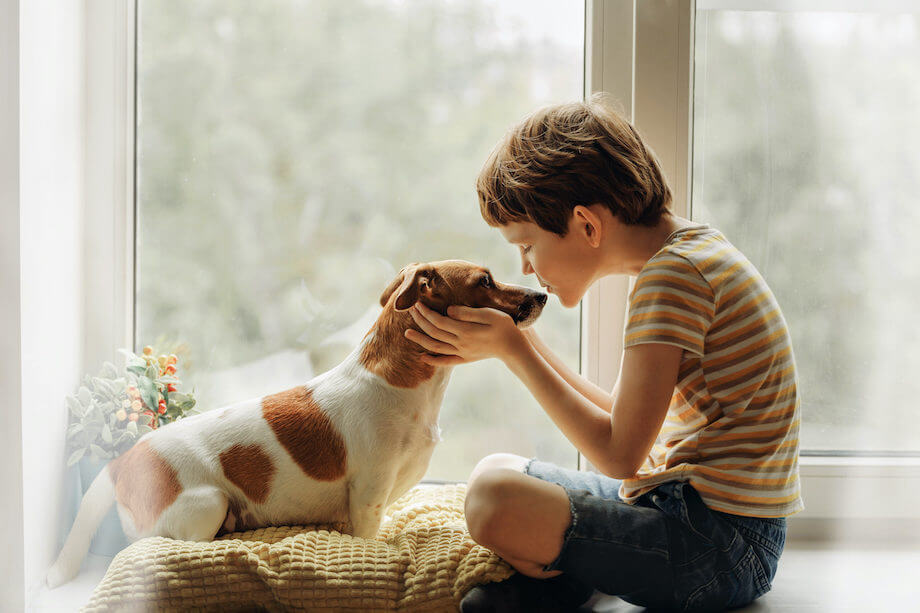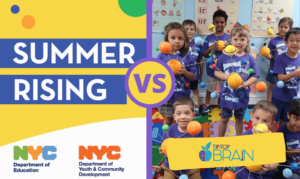Contrary to popular belief, emotional intelligence is learned, not innate. There’s no shortage of ways to develop emotional intelligence, but there’s a family favorite, at least, I think. One of the largest benefits of pets for kids, big or small, and furry or scaly, is that they are catalysts for emotional growth. Emotional intelligence is the ability to manage your own emotions, as well as the tools to relieve stress, communicate effectively, empathize, and resolve conflict. The greater your emotional intelligence, the easier it is to build strong relationships, succeed at school, and achieve your goals. The benefits of pets give their owners (and families) a head start in their emotional development in more ways than one:
1. Pets Teach Children to Think Outside Themselves
As a child, our world is small. We go only where our parents take us, see only what we’re shown, and meet only who we’re introduced to. Consequently, it’s natural for children to have trouble thinking outside of themselves. After all, in a sense, the world has revolved around your child for a while. A pet can be one of the first opportunities for your child to focus on needs outside their own. It’s unlikely you ask your child to meet your personal needs, but a pet certainly would.
Whether it be a cat, dog, rat, or bird, your child’s pet will need water, food, and attention. Regardless of your pet species, they’ll need an attentive owner. Smaller pets may require cage maintenance and cleaning, and bigger pets will require activity throughout the day. The experience of cleaning a guinea pig cage or waking up at sunrise to walk the dog is far from glamorous, but it can be formative.
2. Pets Teach Children Nonverbal Cues
We spend years making a concerted effort to teach our child language, and how to read and write. However, the majority of our communication is nonverbal. Between our facial expressions, gestures, and body language, there’s a lot of nonverbal cues children see modeled for them. Owning a pet encourages children to recognize nonverbal cues and demonstrates the importance of nonverbal communication. Whereas it might be strange to draw attention to a family member or friend’s facial expression, parents can point out when pets make faces: “Boo looks sad today.” As children mature, they can later map their ability to read nonverbal cues onto people.
Don’t forget: Researchers estimate roughly 55% of our communication is nonverbal. Although the statistic has become somewhat cliché, it’s sort of mind-boggling that the majority of our communication transpires through body language alone. Consequently, a head-start observing and interpreting non-verbal communication can be a catalyst for developing emotional intelligence. Of the many benefits of pets for kids, this one is sure to make your child a better communicator.
3. Pets Teach Children Responsibility
Often, kids ask their parents for a pet. Parents are usually reluctant to welcome pets into the family, in fear of endless messes, and new chores. While we ought to be realistic in gauging our child’s ability to care for a pet, especially at a young age, children can learn these responsibilities gradually. No less, if you’re worried a bull mastiff might be too hard to care for, a beta fish or hamster offer many of the same opportunities to learn.
Responsibility is the understanding and action taken to focus and care beyond oneself. The responsibilities pets teach children are often at home and their purpose often somewhat obvious, whether it be walking the dog or changing cat litter. However, these simple, clear responsibilities lay a foundation for more complex, abstract responsibilities outside the home. A sense of obligation beyond oneself allows children to sooner recognize and fulfill responsibilities within their social circles and personal relationships.
4. A Pet is a Child’s Trusted Confidante
Young children can have trouble expressing strong, confusing emotions. Realistically, some things are difficult for children to share with us people, but talking to your dog is easy. When kids need to let things off their chest, but can’t tell their parents, the family pet is all ears. Having an outlet for secrets, or fears, is especially important for children. While your pet may not say much back, their eagerness to listen does wonders enough.
One of the academic benefits of pets for kids is their role in reading time. Pets can serve as a friendly audience for kids when practicing reading aloud or class presentations. It’s common for kids to clam up, or quake in fear at the idea of speaking in front of the class. Your child may take comfort in first being vulnerable with their pet, without fear of social repercussions or embarrassment. Parents work hard to inspire positive thinking and confidence in their child and pets are hear to help!
5. Pets Are Around Through Thick & Thin
Whilst my parents were divorcing, Petey, the family dog, took on some new work around the house. For all of us, he provided an eager wagging tail, and lots of face licks when we needed them. No less, when it came time to move into a new house, Petey made things feel somewhat normal. Luckily, I hadn’t moved far from my old friends, but having my best friend with me made it that much easier.
The reliability of your pet’s friendly face can help mitigate stress for any child, but especially those who, unfortunately, are especially burdened in their home or school lives. For children still developing their emotional intelligence, the presence of a pet offers a healthy, predictable relationship. As your child grows and faces unique stressors and situations which demand new emotional intelligence, your pet can be something of a “north star,” a steady and fixed facet for orienting their emotional journey.
6. Pets Bring Children Laughs & Smiles
Of course, one of the most obvious benefits of pets for kids is that they are natural springs of joy and wonder. Despite the fun games and theatre productions your pet is sure to star in, they needn’t do much to make your child smile. Smiling and laughing are effective tools for emotional regulation! Simply put, pets generate smiles and laughter amongst kids (and everyone else,) but smiles and laughter mean serious business in the study of emotional intelligence. These reactions elicited from us are actually the result of a neurochemical response in our brains, which not only actively makes us smile more, but also frown less!
Ultimately, emotional intelligence is developed over the course of a lifetime. However, maturing emotionally happens most rapidly during our adolescence. It’s no coincidence the emotional skills we pick up in our youth are amongst the most fundamental. Whether or not your child raises a pet, they’re sure to learn, but the benefits of pets for kids offer extremely effective catalysts for emotional development. All in all, emotional intelligence is a truly worthwhile pursuit. The greater your emotional intelligence, the better you can communicate, cope with stress, defuse conflicts, maintain relationships, and empathize, so it’s never too early to hit the “emotional intelligence” books!







